Effect of Acetic Acid on Compressive Strength and Geometric Texture of the Surface of C20/25 Class Concrete
Abstract
:1. Introduction
2. Materials and Methods
2.1. Composition of the Concrete Mixture
2.2. Samples, Their Care and Seasoning
2.3. Measuring pH and Salinity (TDS)
2.4. Compressive Strength
- F—maximum force withstood by the sample (kN),
- Ac—cross-section area of the cubic sample (mm2).
2.5. Microscopic Analysis of Sample Surfaces
3. Results and Discussion
3.1. pH, Salinity (TDS), and Compressive Strength
3.2. Surface Analysis
4. Conclusions
Author Contributions
Funding
Institutional Review Board Statement
Informed Consent Statement
Data Availability Statement
Acknowledgments
Conflicts of Interest
References
- O’Connell, M.; McNally, C.; Richardson, M.G. Biochemical Attack on Concrete in Wastewater Applications: A State of the Art Review. Cem. Concr. Compos. 2010, 32, 479–485. [Google Scholar] [CrossRef]
- De Belie, N.; Verselder, H.J.; De Blaere, B.; Van Nieuwenburg, D.; Verschoore, R. Influence of the Cement Type on the Resistance of Concrete to Feed Acids. Cem. Concr. Res. 1996, 26, 1717–1725. [Google Scholar] [CrossRef]
- Bertron, A.; Duchesne, J.; Escadeillas, G. Accelerated Tests of Hardened Cement Pastes Alteration by Organic Acids: Analysis of the PH Effect. Cem. Concr. Res. 2005, 35, 155–166. [Google Scholar] [CrossRef]
- Bertron, A.; Duchesne, J.; Escadeillas, G. Attack of Cement Pastes Exposed to Organic Acids in Manure. Cem. Concr. Compos. 2005, 27, 898–909. [Google Scholar] [CrossRef]
- Maraveas, C. Durability Issues and Corrosion of Structural Materials and Systems in Farm Environment. Appl. Sci. 2020, 10, 990. [Google Scholar] [CrossRef] [Green Version]
- Živica, V.; Bajza, A. Acidic Attack of Cement Based Materials—A Review. Part 1. Principle of Acidic Attack. Constr. Build. Mater. 2001, 15, 331–340. [Google Scholar] [CrossRef]
- Dąbrowska, M. Wpływ Popiołu Lotnego Wapiennego Na Odporoność Korozyjną Kompozytów Wykonanych z Cementu Portlandzkiego Wieloskładnikowego; Silesian University of Technology: Gliwice, Poland, 2014. [Google Scholar]
- Nidhu, M.S.; Sniktha, V.R.; Benny, L.; Thomas, J.; Ajay, A.; Ramaswamy, K.P. Degradation Kinetics of Alkali-Activated Mortar in Aggressive Citric Acid Environment. IOP Conf. Ser. Mater. Sci. Eng. 2020, 989, 012007. [Google Scholar] [CrossRef]
- Oueslati, O.; Duchesne, J. The Effect of SCMs and Curing Time on Resistance of Mortars Subjected to Organic Acids. Cem. Concr. Res. 2012, 42, 205–214. [Google Scholar] [CrossRef]
- Pavlík, V. Corrosion of Hardened Cement Paste by Acetic and Nitric Acids Part I: Calculation of Corrosion Depth. Cem. Concr. Res. 1994, 24, 551–562. [Google Scholar] [CrossRef]
- Allahverdi, A.; Škvára, F. Acidic Corrosion of Hydrated Cement Based Materials—Part 1. Ceram. Silikáty 2000, 3, 114–120. [Google Scholar]
- Pavlík, V. Corrosion of Hardened Cement Paste by Acetic and Nitric Acids Part II: Formation and Chemical Composition of the Corrosion Products Layer. Cem. Concr. Res. 1994, 24, 1495–1508. [Google Scholar] [CrossRef]
- Pavlík, V. Acid Attack on Hardened Cement Paste by Acids Forming Low Soluble Calcium Salts. IOP Conf. Ser. Mater. Sci. Eng. 2019, 549, 012020. [Google Scholar] [CrossRef]
- Schipanski, M.E.; Bennett, E.M. The Influence of Agricultural Trade and Livestock Production on the Global Phosphorus Cycle. Ecosystems 2012, 15, 256–268. [Google Scholar] [CrossRef]
- Rodrigues, J.; Alvarenga, P.; Silva, A.C.; Brito, L.; Tavares, J.; Fangueiro, D. Animal Slurry Sanitization through PH Adjustment: Process Optimization and Impact on Slurry Characteristics. Agronomy 2021, 11, 517. [Google Scholar] [CrossRef]
- Allahverdi, A.; Škvára, F. Acidic Corrosion of Hydrated Cement Based Materials Part 2—Kinetics of the Phenomenon and Mathematical Models. Ceram. Silikaty 2000, 44, 152–160. [Google Scholar]
- Aiken, T.A.; Kwasny, J.; Sha, W. Resistance of Fly Ash Geopolymer Binders to Organic Acids. Mater. Struct. Constr. 2020, 53, 115. [Google Scholar] [CrossRef]
- Barbhuiya, S.; Kumala, D. Behaviour of a Sustainable Concrete in Acidic Environment. Sustainability 2017, 9, 1556. [Google Scholar] [CrossRef] [Green Version]
- Mariam Ninan, C.; Ajay, A.; Ramaswamy, K.P.; Thomas, A.V.; Bertron, A. A Critical Review on the Effect of Organic Acids on Cement-Based Materials. IOP Conf. Ser. Earth Environ. Sci. 2020, 491, 012045. [Google Scholar] [CrossRef]
- De Windt, L.; Bertron, A.; Larreur-Cayol, S.; Escadeillas, G. Interactions between Hydrated Cement Paste and Organic Acids: Thermodynamic Data and Speciation Modeling. Cem. Concr. Res. 2015, 69, 25–36. [Google Scholar] [CrossRef] [Green Version]
- Ajay, A.; Ramaswamy, K.P.; Thomas, A.V. Degradation Kinetics of Alkali-Activated Pastes in Acetic Acid. IOP Conf. Ser. Mater. Sci. Eng. 2020, 989, 012010. [Google Scholar] [CrossRef]
- Bertron, A.; Duchesne, J. Attack of Cementitious Materials by Organic Acids in Agricultural and Agrofood Effluents. Perform. Cement Based Mater. Aggress. Aqueous Environ. 2013. [Google Scholar] [CrossRef]
- Tilman, D.; Fargione, J.; Wolff, B.; D’Antonio, C.; Dobson, A.; Howarth, R.; Schindler, D.; Schlesinger, W.H.; Simberloff, D.; Swackhamer, D. Forecasting Agriculturally Driven Global Environmental Change. Science 2001, 292, 281–284. [Google Scholar] [CrossRef] [Green Version]
- Voegel, C.; Bertron, A.; Erable, B. Mechanisms of Cementitious Material Deterioration in Biogas Digester. Sci. Total Environ. 2016, 571, 892–901. [Google Scholar] [CrossRef] [Green Version]
- Živica, V. Acidic Attack of Cement Based Materials—A Review Part 3: Research and Test Methods. Constr. Build. Mater. 2004, 18, 683–688. [Google Scholar] [CrossRef]
- Larreur-Cayol, S.; Bertron, A.; Escadeillas, G. Degradation of Cement-Based Materials by Various Organic Acids in Agro-Industrial Waste-Waters. Cem. Concr. Res. 2011, 41, 882–892. [Google Scholar] [CrossRef]
- Dyer, T. Influence of Cement Type on Resistance to Attack from Two Carboxylic Acids. Cem. Concr. Compos. 2017, 83, 20–35. [Google Scholar] [CrossRef] [Green Version]
- Živica, V. Deterioration of Cement-Based Materials Due to the Action of Organic Compounds. Constr. Build. Mater. 2006, 20, 634–641. [Google Scholar] [CrossRef]
- Taku, K.J.; Amartey, D.Y.; Kassar, T. Effect of Acidic Curing Environment on the Strength and Durability of Concrete. Civ. Environ. Res. 2015, 7, 8–13. [Google Scholar]
- Wiśniewski, K.; Dohojda, M.; Witkowska-Dobrev, J. Ochrona Betonu Zwykłego Przed Agresywnym Środowiskiem w Budownictwie Rolniczym. ACTA Sci. Pol. Archit. Bud. 2020, 18, 83–93. [Google Scholar] [CrossRef]
- Slama, M.B.H.; Maloufi, N.; Guyon, J.; Bahi, S.; Weiss, L.; Guitton, A. In Situ Macroscopic Tensile Testing in SEM and Electron Channeling Contrast Imaging: Pencil Glide Evidenced in a Bulk β -Ti21S Polycrystal. Materials 2019, 12, 2479. [Google Scholar] [CrossRef] [Green Version]
- Perez, F.; Bissonnette, B.; Courard, L. Combination of Mechanical and Optical Profilometry Techniques for Concrete Surface Roughness Characterisation. Mag. Concr. Res. 2009, 61, 389–400. [Google Scholar] [CrossRef]
- Santos, P.M.D.; Júlio, E.N.B.S.; Silva, V.D. Correlation between Concrete-to-Concrete Bond Strength and the Roughness of the Substrate Surface. Constr. Build. Mater. 2007, 21, 1688–1695. [Google Scholar] [CrossRef] [Green Version]
- Jamroży, Z. Beton i Jego Technologie; Wydawnictwo naukowe PWN: Warsaw, Poland, 2015. [Google Scholar]
- PN-EN 12350-2:2019-07. Testing Fresh Concrete. Pat 2: Slump Test; Comite Europeen de Normalisation: Brussels, Belgium, 2019. [Google Scholar]
- Pavlík, V. Corrosion of Hardened Cement Paste By Acetic and Nitric Acids. Part III: Influence of Water/Cement Ratio. Cem. Concr. Res. 1996, 26, 475–490. [Google Scholar] [CrossRef]
- PN-EN 206+A1:2016-12. Concrete—Specification, Performance, Production, and Conformity; Polish Committee for Standardization: Warsaw, Poland, 2016. [Google Scholar]
- PN-B-06265:2018-10. Concrete—Specification, Performance, Production, and Conformity. National Supplement to PN-EN 206+A1:2016-12; Polish Committee for Standardization: Warsaw, Poland, 2018. [Google Scholar]
- Oueslati, O.; Duchesne, J. Impact of Acetic Acid Attack on the Chemical, Physical and Mineralogical Evolution of Cement Pastes. In Proceedings of the 7th International Symposium on Cement Based Materials for a Sustainable Agriculture (CIGR International Symposium), Québec City, QC, Canada, 18–21 September 2011; Godbout, S., Potvin, L., Eds.; pp. 28–37. [Google Scholar]
- Jurak, D. Wpływ Korozji Chemicznej Na Wytrzymałość Na Ściskanie Betonu Konstrukcyjnego C20/25; Warsaw University of Life Sciences: Warsaw, Poland, 2020. [Google Scholar]
- PN-EN 12390-3:2019-07. Title. Testing Hardened Concrete—Part 3: Compressive Strength of Test Specimens; Polish Committee for Standardization: Warsaw, Poland, 2019. [Google Scholar]
- PN-EN ISO 4287:1999. Geometrical Product Specifications (GPS)—Surface Texture: Profile Method—Terms, Definitions and Surface Texture Parameters; Polish Committee for Standardization: Warsaw, Poland, 1999. [Google Scholar]
- PN-EN ISO 25178-600:2019-05. Geometrical Product Specifications (GPS)—Surface Texture: Areal—Part 600: Metrological Characteristics for Areal Topography Measuring Methods; Polish Committee for Standardization: Warsaw, Poland, 2019. [Google Scholar]
- Liu, J.; Zha, F.; Deng, Y.; Cui, K.; Zhang, X. Effect of an Alkaline Environment on the Engineering Behavior of Cement-Stabilized/Solidified Zn-Contaminated Soils. Environ. Sci. Pollut. Res. 2017, 24, 28248–28257. [Google Scholar] [CrossRef] [PubMed]
- Živica, V.; Bajza, A. Acidic Attack of Cement-Based Materials—A Review Part 2. Factors of Rate of Acidic Attack and Protective Measures. Constr. Build. Mater. 2002, 16, 215–222. [Google Scholar] [CrossRef]
- Xie, Y.; Lin, X.; Ji, T.; Liang, Y.; Pan, W. Comparison of Corrosion Resistance Mechanism between Ordinary Portland Concrete and Alkali-Activated Concrete Subjected to Biogenic Sulfuric Acid Attack. Constr. Build. Mater. 2019, 228, 117071. [Google Scholar] [CrossRef]



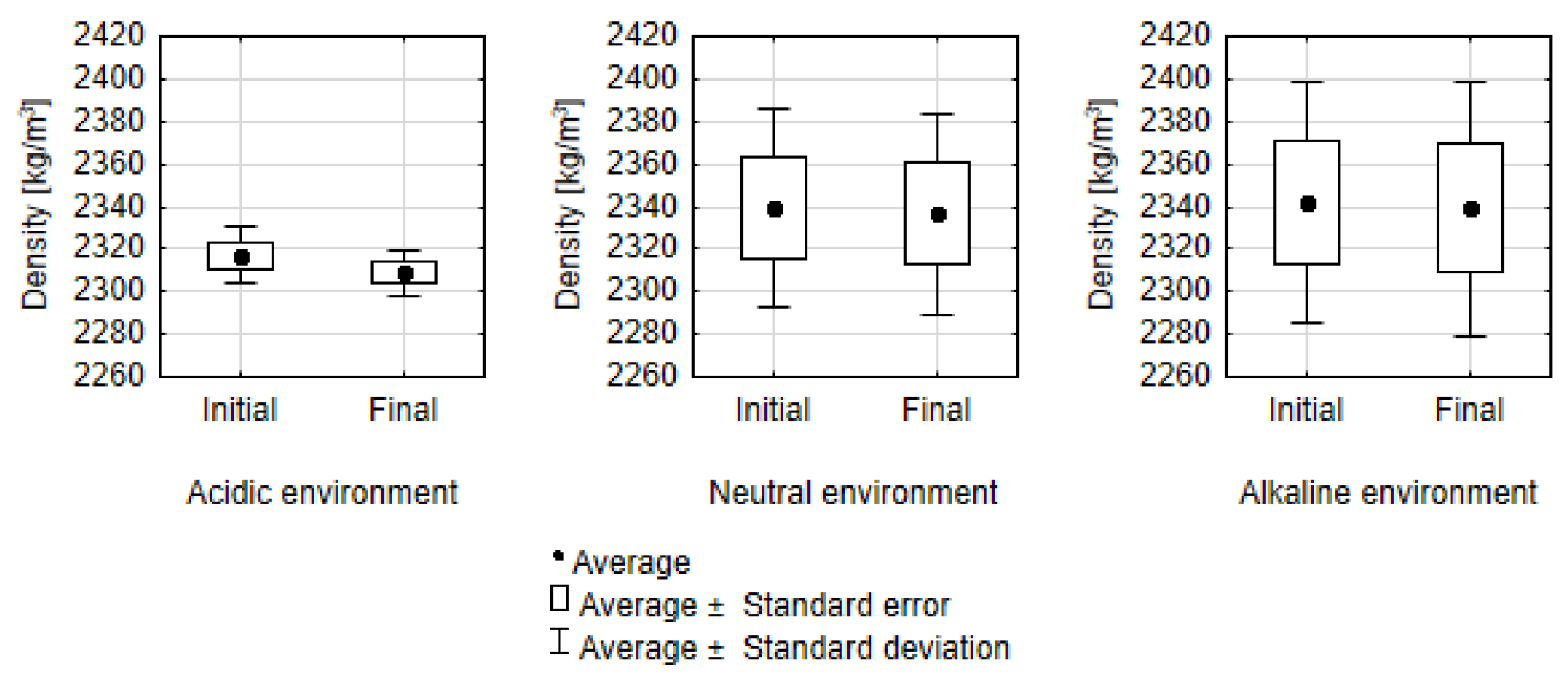

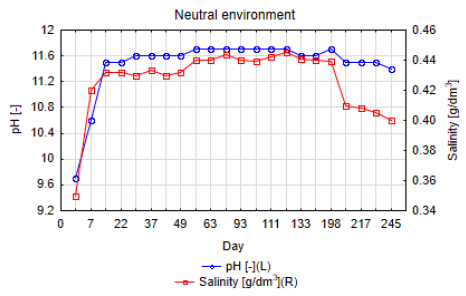

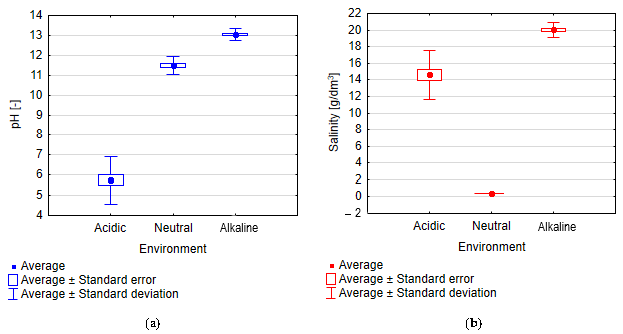

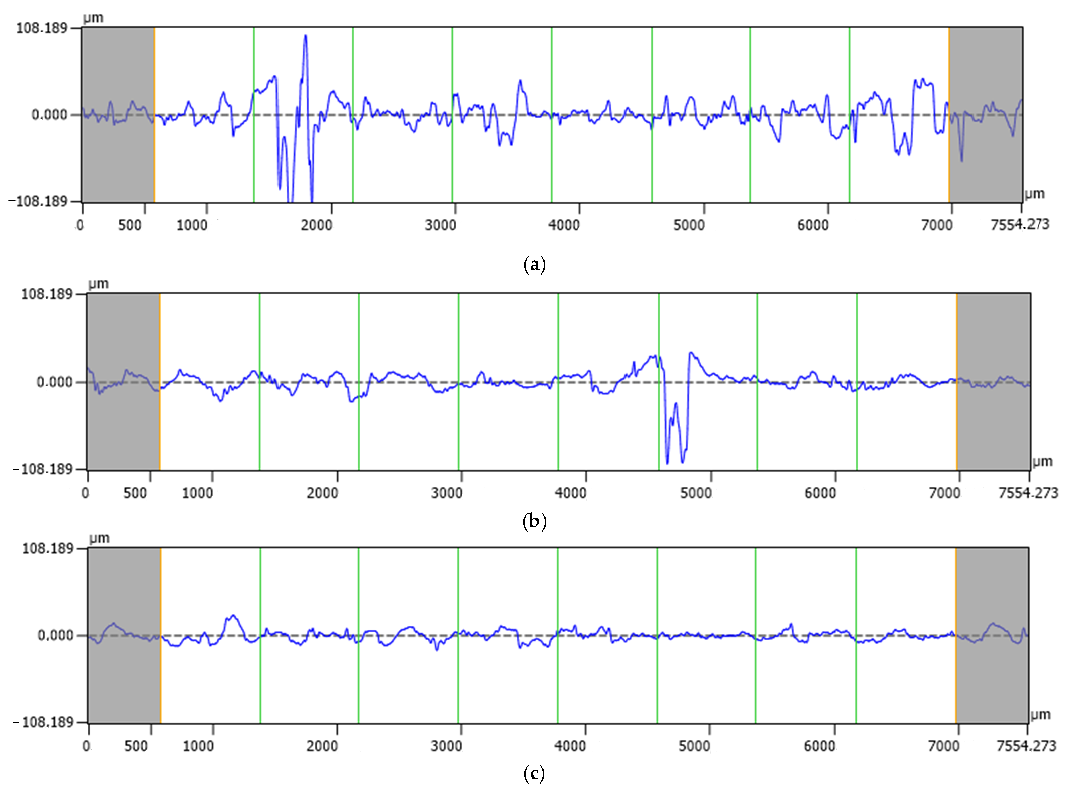

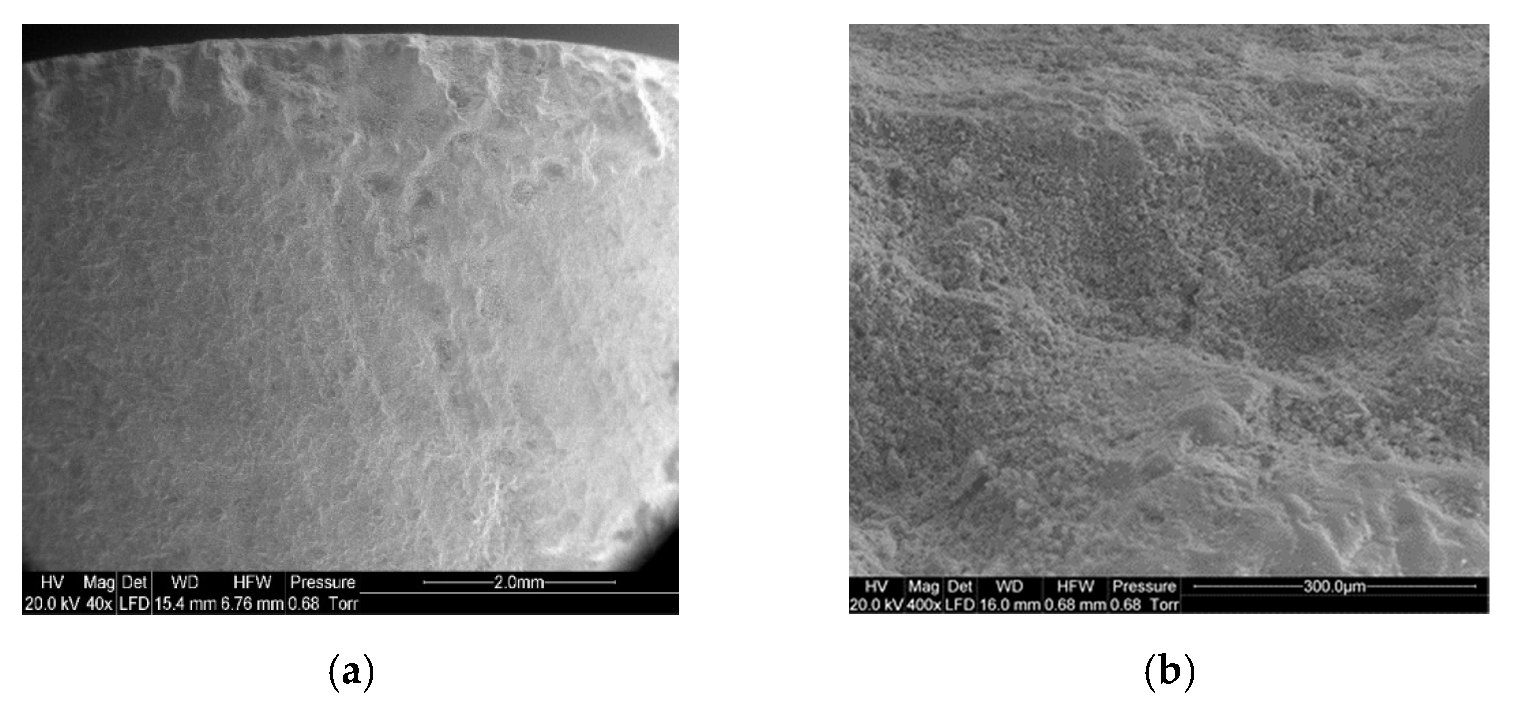
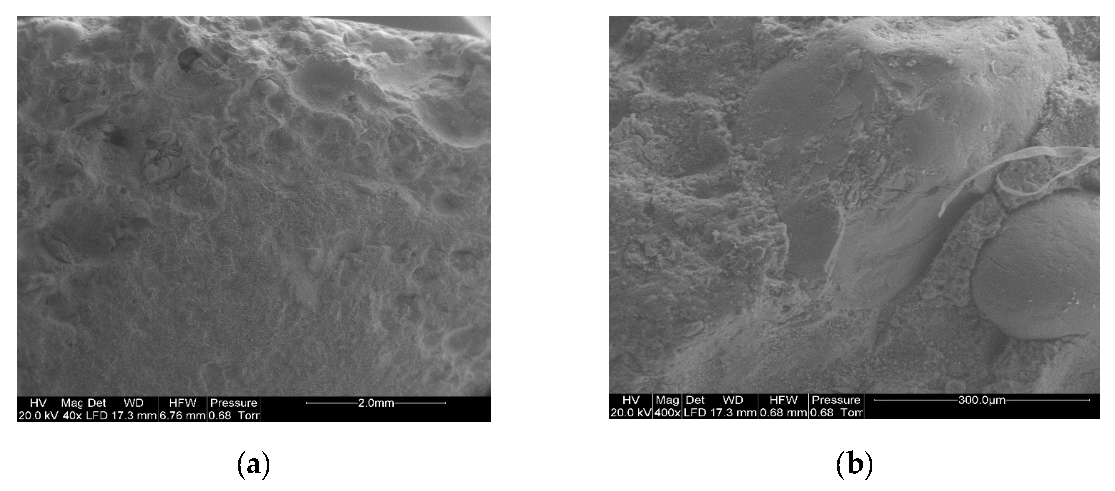
| Composite | Quantity per 1 m3 (kg) |
|---|---|
| Cement | 372.87 |
| Water | 172.09 |
| Aggregate fraction 0–2 mm | 822.79 |
| Aggregate fraction 2–4 mm | 187.00 |
| Aggregate fraction 4–8 mm | 486.20 |
| Aggregate fraction 8–16 mm | 561.00 |
| Dye | pH (–) | Conductivity (mS/dm3) | TDS (mg/dm3) | Temperature (°C) |
|---|---|---|---|---|
| Methyl blue | 4.87 | 224 | 125.3 | 20.4 |
| Methyl red | 9.86 | 61.8 | 30.8 | 20.5 |
| Crystal violet | 4.51 | 93.8 | 47.4 | 20.5 |
| Methyl orange | 9.88 | 66.4 | 32 | 20.5 |
| Distilled water | 9.65 | 139 | 70.3 | 20.4 |
| Environment | CV for pH | CV for TDS |
|---|---|---|
| Acidic | 20.59 | 20.62 |
| Neutral | 4.00 | 5.10 |
| Alkaline | 2.21 | 4.44 |
| Environment | Ra (µm) | Rz (µm) |
|---|---|---|
| Acidic | 14.273 | 80.081 |
| Neutral | 9.143 | 44.831 |
| Alkaline | 4.817 | 23.208 |
| Air-dry | 1.927 | 9.288 |
| Parameter | Acidic Environment | Neutral Environment | Alkaline Environment | Air-Dry |
|---|---|---|---|---|
| Arithmetical mean height of the surface Sa (µm) | 23.39 | 11.45 | 5.96 | 2.75 |
| Maximum height of the surface Sz (µm) | 179.39 | 76.81 | 39.53 | 16.89 |
| Root mean square height of the surface Sq (µm) | 29.75 | 13.95 | 7.21 | 4.23 |
| Skewness of height distribution Ssk (-) | −0.11 | 0.01 | 0.11 | 0.02 |
| Kurtosis of height distribution Sku (-) | 3.07 | 2.55 | 2.42 | 2.12 |
| Maximum height of peaks Sp (µm) | 82.11 | 39.15 | 23.44 | 10.13 |
| Maximum height of valleys Sv (µm) | 97.28 | 37.67 | 16.09 | 6.76 |
Publisher’s Note: MDPI stays neutral with regard to jurisdictional claims in published maps and institutional affiliations. |
© 2021 by the authors. Licensee MDPI, Basel, Switzerland. This article is an open access article distributed under the terms and conditions of the Creative Commons Attribution (CC BY) license (https://creativecommons.org/licenses/by/4.0/).
Share and Cite
Witkowska-Dobrev, J.; Szlachetka, O.; Dohojda, M.; Wiśniewski, K. Effect of Acetic Acid on Compressive Strength and Geometric Texture of the Surface of C20/25 Class Concrete. Sustainability 2021, 13, 5136. https://doi.org/10.3390/su13095136
Witkowska-Dobrev J, Szlachetka O, Dohojda M, Wiśniewski K. Effect of Acetic Acid on Compressive Strength and Geometric Texture of the Surface of C20/25 Class Concrete. Sustainability. 2021; 13(9):5136. https://doi.org/10.3390/su13095136
Chicago/Turabian StyleWitkowska-Dobrev, Joanna, Olga Szlachetka, Marek Dohojda, and Krzysztof Wiśniewski. 2021. "Effect of Acetic Acid on Compressive Strength and Geometric Texture of the Surface of C20/25 Class Concrete" Sustainability 13, no. 9: 5136. https://doi.org/10.3390/su13095136






